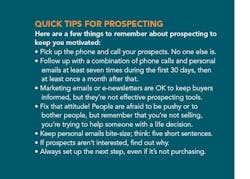If You Want More Sales ... Prospect Like a Boss
Prospecting is hard work. It’s tough and it’s time-consuming. That’s why most salespeople don’t follow up with leads that have been sitting around too long. If that sounds familiar, you can pretty much count on your competition doing the same.
To get some data about that aspect of prospecting, we added a wrinkle to our annual survey of sales lead follow-up tactics used by production builders. In addition to tracking their responses to leads within the first 30 days, we also circled back six months after our initial inquiry to see how (or if) they had continued to prospect our online lead. But before we get into those results, let’s talk more generally about why you should care more about prospecting.
Our annual study shows that home builders and salespeople are generally happy to keep up with prospects for the first 30 days when motivation is high on both ends. But what happens after that, when the lead hasn’t taken action? Builders think if a customer hasn’t responded within that time frame, they aren’t interested or serious about buying. And because prospecting is hard work, builders quickly lose interest in those leads.
But we know from experience and data that not all buyers make homebuying decisions during the first 30 days. In fact, up to 40% of sales will happen after the first month—but only if you stay in front of those buyers.
If you make the logical assumption that your competition gives up on a lead after 30 days, you have an incredible opportunity to stand out from other builders and make sales no one else is pursuing.
RELATED
- Seeing the Future of Online Sales
- The Top 10 Mistakes Sales Managers Make (and How to Avoid Them)
- How Good Is Your Online Lead Follow-Up?
Testing Builders’ Long-Term Prospecting Efforts
Our annual study of 100 production builders regarding online lead response times and follow-up activities revealed that only a third (34%) used the phone to follow-up within the first month, while the near-reverse percentage (64%) sent either a personal email or a marketing (or HTML e-newsletter) email. Another 16% sent a text message, which our “interested buyer” indicated was an acceptable form of follow-up.
Six months later, we logged back in to our covert buyer’s voicemail account, email inbox, and text platform to see how builders continued to prospect our lead.
The results were surprising: In the sixth month, our buyer received 154 marketing emails, six personal emails (three from the same person), two text messages, and one phone call. That’s right: Just six salespeople out of 100 personally reached out to the lead in the sixth month after we initially posted it. This data makes it pretty clear that most builders and salespeople aren’t following up with prospects once that 30-day window has passed.
But it also reveals an important point I want to make: the difference between marketing emails and personal follow-ups.
Email Marketing Is Not Follow-Up
Many builders send out newsletters via email and count it as sales follow-up. But email marketing and personal follow-up emails are different in just about every way, down to how people react when they receive one.
For example, people don’t (and often can’t) reply to marketing emails. Though they may click on something to get to the home builder’s or the community’s website, all they really see is some pretty graphics. Leads aren’t going to reach out with questions or for information after receiving a marketing email. They’re not inviting and don’t encourage or enable that conversation.
On the other hand, personal follow-up (or “lead-nurturing”) emails invite leads to start or continue a conversation. When you send an email from a personal address to a specific person (lead), it is, by definition, more personal and engaging. Leads feel prompted to respond because it feels like (and likely is) a genuine, human interaction and response to an inquiry.
It’s OK to send both types of emails; no one should rely on a single method to nurture leads. But data proves that people are far more likely to respond to a personal email. In fact, lead-nurturing emails have four to 10 times the response rate, compared with marketing emails or templated email blasts sent to several leads at once. Consider that stat the next time you set out to nurture your leads, especially those beyond the 30-day window. Again: Email marketing is not follow-up. You have to put the personal effort in to nurture your leads.
Pick Up the Phone for Lead Follow-Up
During the entire sixth month of our home builder lead follow-up study, our buyer received a single phone call. One. The comments we left in the online lead form specifically noted that builders should, “Feel free to call, email, or text” a follow-up. Our secret shopper was welcoming phone calls, but builders and their salespeople have essentially stopped using the phone.
Today we see a real reluctance to make phone calls in the home building industry. Home builder salespeople believe that sending an email is enough; that it counts as reaching out. But just one in four personal emails are opened and engaged with by the recipient.
We need to start picking up the phone. On average, people only get about six phone calls a day. If you’re one of those calls, you have a much better opportunity to move that customer forward in the sales process.
Calls and Emails to Leads: a Super-Charged Follow-Up
If you bundle phone calls and personal emails to your leads, the response rate will go up by 30%. Even if you just leave a voicemail to let your lead know you sent an email, that can be enough to prompt a response.
Remember, also, that we only received one phone call and six personal emails in the sixth month of our study. Imagine the competitive edge you’d gain by sending personal email follow-ups and calling your leads.
A Word About Texting Your Buyers
Text messaging is an increasingly popular (and often preferred) way to stay in touch with homebuyers once a contract is signed or serious interest is established to keep a conversation going. But it is rarely used as a prospecting tool.
One-to-one texting with your leads is fine as long as you are respecting a prospect’s communication preferences. However, by law, you need permission from prospects to send text messages via a mass-marketing tool. It’s a tricky business, and it presents a real risk. We’ll delve deeper into it in a future issue.
RELATED
Put the Work in Now for Long-Term Results
Yes, prospecting can be grueling work. That’s why most builder salespeople don’t keep up with it. It’s the first thing that’s dropped when salespeople are busy, or they simply lose interest.
But it’s incredibly important for home builders and salespeople to be disciplined in long-term prospecting. Realistically, you should be spending about two hours every day on it because the sales are there—you just have to be patient and work for them.
You can count on your competition giving up on prospecting because it’s easy to let it slide. But you can be successful by consistently reaching out and following up with prospects. As pastor Craig Groeschel puts it: “Successful people do consistently what others do occasionally.”



